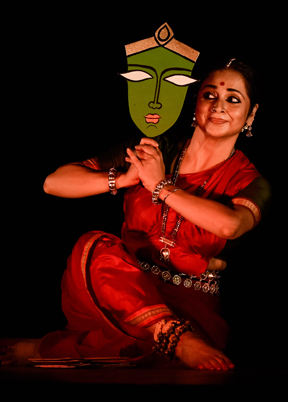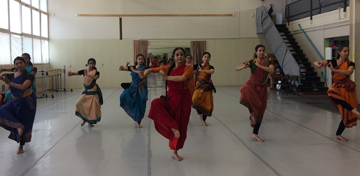
PALO ALTO, CA: On a beautiful fall day, I step into the quiet, artsy environment of Cubberley Community Theater in Palo Alto, California.
Inside a hall -Dance Vision studio – a class is on. A strikingly beautiful woman leads a group of adult and teenaged women, both of Indian and non-Indian ancestry. As the class ends, I have the honor of being introduced to one of India’s great classical dancers and gurus – Ms. Sharmila Biswas, who has been practicing, teaching and innovating Odissi. She is the recipient of one of India’s highest honors for the performing arts – the Sangeet Natak Akademi Award.
Here is an excerpt of an interview with Ms. Biswas.
India Post: Do you come here very often and teach?
Sharmila Biswas: No, not at all. I don’t have many classes and workshops. My concept of teaching is that if I am in Calcutta (Kolkata), you come and learn and people do come; sometimes they come from all over the world. I feel that it is in our Indian arts and music, it is still a very oral tradition that gets passed from one generation to the next through the vision of the guru. So it is one vision and it becomes one united vision of the teacher and the student. And that united vision is not possible if I do not have that kind of bonding with my student. I need to possess the student to teach.
But here, I felt that from the beginning that I am within my world. Somehow I feel at home here.
IP: As an artist, you started at a very young age and you have achieved so much. Did you feel that pursuing an artistic path versus just taking up a job or living a regular life, was it tougher in the past or tougher now?
SB: Oh, I don’t know. I personally feel that when you really want something, the doors open. God gives everyone one chance, one little door. But you have to notice the door. Knowing yourself is the most important thing.
And you know struggle at every stage is different. When I was very young, I was dancing. There was no struggle. Then in the early 20s, the struggle was to learn.
Then, in the career, for the artist, I didn’t know whether I could call myself a professional or not. Then someone told me, “Of course, doesn’t matter if you are not earning a single penny, you are still a professional because you have attitude of a professional, you are doing it!”
After crossing 50, it is a whole big new life for me…because I am into research and creation, not just dancing.
IP: We have a lot of dance schools in the Bay Area, both classical as well as other forms, and of course, Bollywood. Some people feel that our classical art forms are being compromised. What are your thoughts on this?
SB: Popular art has always occupied a much bigger space in cities, in villages, everywhere. And side-by-side, our art also existed…in the past, even now. It is just that everything is very visible now.
We have to accept that popular art will always happen and most people will run after that. But we will exist in spite of that, because that’s the need of the people, the need to co-exist and take from each other.
IP: You did something in Puri with the ‘devdaasis’. Could you tell us something more about that?
SB: When I started my research in my early 30s, one of my first projects was to know the root. I went to Puri to not only interact with the ‘devdaasis’ – the temple dancers – but also to interact with the old scholars. I was fortunate to meet two ‘devdaasis’, the last two ones – the people who knew the system very well. And I created a production called ‘Sampurna’, which means “a complete woman”.
It came out of one sentence, which Shashimani (one of the ‘devdaasis’) told me.
I said, “All this you are saying…your husband Jagannath, your son, Gopal, your Krishna in the ‘raas’, they are not real…”
She said, “What makes you think that your husband is real? Your husband is flesh and blood, which diminishes each year and my Gopal comes to me every year in the form of a baby. My Krishna comes with all the colors in the ‘raas’. My husband comes to me every night when I go to him. And who are you to say that your husband is more real than mine?”
So that completeness I saw. We choose our planes; we choose our bubble. So that was her bubble. And I wanted to be a part of that bubble.
IP: Classical art has always been involved in the development of society. My mother used to say that if you learn some form of art, it will always develop your character.
SB: Well, unfortunately, it is not as simple as that. It started with fourteen ‘Vidyas’ – pure sciences. Out of these fourteen ‘Vidyas’, sixty-four ‘Kalas’ – arts -emerged, which took the elements from these ‘Vidyas’ – the knowledge – and made it beautiful.
And it was through the bodies and the voices of those ‘devdaasis’ that all those fourteen ‘Vidyas’ converted into sixty-four ‘Kalas’, to educate the people.
But something somewhere got twisted in our history of development of art… the ‘devdaasis’ would have probably ended…died…they should have died a natural death and something would have emerged out of that. But they did not die a natural death. It was our colonial government, which came and decided what is moral and what is immoral.

But they were the only educated women who were actually earning.
And later on, it happened in 1947 -‘Devdaasi’ Act. There was this urge that India is so big, India is so cultured… let us showcase. So who were showcased? Not the ‘devdaasis’ but people who had money, who had power, who had political clout. So that part of the history I dislike and we are suffering from it.
IP: What are your plans as a teacher? What is your vision for this near future?
SB: Well, there is so much work to do…Basically, my thing is to dig out from the past -tradition – and make a production and show.
Then, Odissi music excites me a lot.
Then, curriculum for children. I love teaching. So I am into that -teaching – big time; school children, who don’t want to be professional dancers but they want to dance. But are we going to teach them ‘Odissi’, ‘Bharatnatyam’? No. Dance, which is multifaceted.
So there are many dreams. I hope I’ll be able to have the opportunity to do it, I mean the time. I need another 100 years (laughs)
Lakshmi Iyer
India Post News Service






